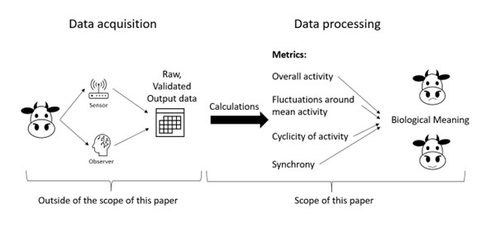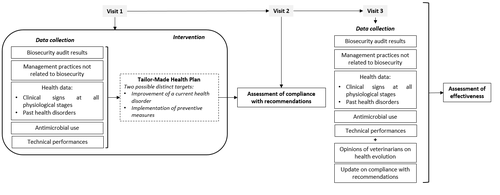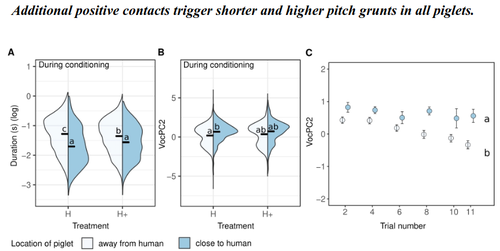Recommendations: 2

From data on gross activity to the characterization of animal behaviour: which metrics for which purposes?
A guide to improving the use of activity data in animal research
Recommended by Matteo Chincarini based on reviews by Birte L Nielsen and Anna OlssonIn production animals, behavioural activity plays a crucial role across a wide range of scientific disciplines and is often measured for various purposes depending on the field: ethology, animal welfare, reproduction, animal production, and so on. Historically, direct observation was the primary method of collecting such data, a process that was time-consuming and prone to possible observer bias. With the advent of automated systems and sensors, behavioural activity can now be recorded continuously and non-invasively, leading to a growing body of more reliable data (1). However, the lack of standardisation in how these data are calculated and interpreted has created challenges for cross-study comparisons. To fully harness the potential of studying behavioural activity, scientific studies must harmonise the methods used to calculate this measure. Standardising these methods would make it easier to compare results and identify possible gaps in knowledge.
In the work by van Dixhoorn et al.(2), the authors examine the various metrics most commonly used to study behavioural activity. Through a series of examples, they address the definitions, calculation methods, and biological significance of metrics such as overall activity, fluctuations around mean activity, cyclicity of activity, and synchrony between animals. The authors suggest how these different metrics can be applied in specific contexts and guide readers in using appropriate terminology to ensure future studies are more easily comparable. In addition, by clarifying these concepts, the authors provide researchers with the tools to make informed decisions about which metric best suits their study's objectives.
A key contribution of this work is its emphasis on standardising the metrics and terminology used in behavioural activity studies. Studies using different metrics may arrive at conclusions that appear contradictory, not because of actual differences in animal behaviour, but due to inconsistencies in how behaviour is quantified. By advocating for a common framework, the authors aim to improve the replicability of studies, facilitate meta-analyses, and allow for a more cohesive understanding of animal behaviour across different research groups. This, in turn, could accelerate the identification of key behavioural indicators, ultimately leading to better animal management practices and welfare assessments.
This article provides a timely and valuable contribution to the field of animal science. As technology continues to evolve, so too must our methods for interpreting the vast amounts of data it generates (3). By ensuring that studies are comparable and data is interpreted consistently, the research community can work towards more meaningful discoveries in animal behaviour. I highly recommend this paper to researchers looking to deepen their understanding of activity metrics in animal behaviour studies.
References
1. Rushen J, Chapinal N, de Passilé AM (2012). Automated monitoring of behavioural-based animal welfare indicators. Animal Welfare 21(3):339-50. https://doi.org/10.7120/09627286.21.3.339
2. van Dixhoorn IDE, Aubé L, van Zyl C, de Mol R, van der Werf J, Lardy R, Mialon MM, van Reenen CG, and Veissier I (2024). From data on gross activity to the characterization of animal behaviour: which metrics for which purposes?. Zenodo, 10420600, ver.5 peer-reviewed and recommended by PCI Animal Science. https://doi.org/10.5281/zenodo.10420600
3. Riaboff L, Shalloo L, Smeaton AF, Couvreur S, Madouasse A, Keane MT (2022). Predicting livestock behaviour using accelerometers: A systematic review of processing techniques for ruminant behaviour prediction from raw accelerometer data. Computers and Electronics in Agriculture 192:106610. https://doi.org/10.1016/j.compag.2021.106610

Combining several indicators to assess the effectiveness of tailor-made health plans in pig farms
Evaluating tailor-made health plans in pig farms: a multiple complementary indicators approach
Recommended by Matteo Chincarini based on reviews by Carla Gomes and 1 anonymous reviewerTailor-made health plans for farming animals, including pigs, are highly beneficial due to their customized nature, addressing the unique needs of each farm and promoting efficient husbandry practices. However, assessing the effectiveness of individualized approaches can be challenging. Levallois et al. (1) tackled this challenge by evaluating the effectiveness of tailor-made health plans of pig farms based on a systematic biosecurity and herd health audit. The study involved twenty farrow-to-finish pig farms, each receiving specific plans tailored to their specific needs. Compliance with the recommendations was monitored over an eight-month period. In the literature, various studies have delved into specific issues in detail, such as disease incidence (e.g., (2)). However, the authors of this research applied a comprehensive approach through an integrative analysis of multiple complementary indicators to provide an effective evaluation of the changes and health disorders.
The authors' holistic approach to measuring the effectiveness of tailor-made health plans is noteworthy. They employed up to seven methods to identify advantages and limitations, providing valuable insights for applied research and practitioners in the field of farm animals. Additionally, the study's inclusion of diverse farms, ranging from conventional to antibiotic-free and varying in sow breeding numbers (from 70 to 800), demonstrates the flexibility of the proposed approach, accommodating different farming systems.
The study revealed three crucial considerations for future evaluations of tailor-made health plans. Firstly, placing compliance as the primary assessment indicator is a priority. Secondly, it is essential to tailor outcome indicators and monitoring periods according to each farm's specific health disorder. Lastly, a comprehensive understanding of the health disorder's evolution can be achieved through the amalgamation of multiple indicators.
While the study does have limitations, such as the relatively short time window for assessment, the methodological framework and results are promising. Further, the discussion of the results raises several areas worthy of future investigation to improve compliance and address farmers' hesitations towards action (i.e., lack of willingness). More research in this context will be beneficial for veterinarians and practitioners, enhancing their understanding and positively impacting both farmers and animals.
In conclusion, the study underscores the significant impact of tailor-made health plans on promoting positive changes in farm management. Assessing the effectiveness of these plans enables the refinement of new strategies and enhances the overall quality of work in animal production. The study by Levallois et al (1) sheds valuable light on the challenges and potentials of such plans, providing essential insights for pig farming practices. While further research and improvements are necessary, the study strongly emphasizes the pivotal role of individualized approaches in attaining improved farm management and enhancing animal welfare.
References:
1. Levallois P, Leblanc-Maridor M, Scollo A, Ferrari P, Belloc C, Fourichon C. (2023). Combining several indicators to assess the effectiveness of tailor-made health plans in pig farms. Zenodo, 7789634. ver. 3 peer-reviewed and recommended by Peer Community in Animal Science. https://doi.org/10.5281/zenodo.7789634
2. Collineau L, Rojo-Gimeno C, Léger A, Backhans A, Loesken S, Nielsen EO, Postma M, Emanuelson U, grosse Beilage E, Sjölund M, Wauters E, Stärk KDC, Dewulf J, Belloc C, Krebs S. (2017). Herd-specific interventions to reduce antimicrobial usage in pig production without jeopardising technical and economic performance. Preventive veterinary medicine, 144:167-78. https://doi.org/10.1016/j.prevetmed.2017.05.023
Reviews: 2
Shade use, welfare and performance of ewes grazing in temperate silvopastures differing in tree density
Provision of optimal shade for ewes: a question of choice
Recommended by Birte L Nielsen based on reviews by Matteo Chincarini and Pol LlonchAs the world slowly (or not so slowly) warms, the ability to regulate heat becomes even more pertinent for livestock kept in enclosed areas. Trees are not always present on land grazed by sheep, and when the pasture has some forestation, the coverage will provide varying degrees of shade. In this study by Ginane et al. (2025), ewes kept in enclosures with different levels of tree cover were observed at different times over a period of three years to investigate the extent to which the animals chose to spend time in the shade. By using fields with very different provision of shade (approximately 1, 40, and 81% shade, respectively), the authors wanted to test the hypothesis that ewes would actively seek out tree shade when the combined temperature and humidity increased – especially if the conditions reached levels associated with heat stress. Even at the lowest provision of shade, which consisted of a single tree in the paddock, all ewes could fit within the shade cast by the tree; but if the distribution of ewes or groups of ewes were random, i.e. independent of shade, the likelihood of these ewes being in the shade by chance was effectively 1%. By factoring in the element of chance, the authors found that mean shade use was greater than the tree canopy cover for the low and medium shade treatments, whereas it didn’t differ from chance for the densely forested treatment. Across treatments, all ewes spent just under 60% of the observation time grazing, and the ewes with the low and medium level of shade actively selected shade for foraging activity, whereas the ewes with over 80% canopy cover avoided it. Across treatments, shade was used primarily for resting and ruminating.
Tree cover affected the availability of forage in a negative manner, with more biomass available for ewes in the low shade treatment and significantly less in the high treatment, although this did not translate into significant differences in live weight or body condition score. Using this information, Ginane et al. (2025) calculated the optimal level of tree cover to be somewhere between the low and medium cover, at roughly 30 trees per hectare – preferably spread out over the area to offer different locations of shade and to encourage a natural spread of manure.
This longitudinal study of shade use by ewes provides novel and useful information on the positive and negative effects of tree cover in paddocks used to rear ewes with lambs. The authors raise the limitation of the study themselves, and they would have liked to also include observations on non-sunny days, to be able to eliminate place preferences independently of shade availability. But the clever calculation of active shade-selection makes this study easily applicable for use in the assessment of paddock suitability for pregnant ewes.
References
Cécile Ginane, Mickaël Bernard, Véronique Deiss, Donato Andueza, Camille Béral (2025) Shade use, welfare and performance of ewes grazing in temperate silvopastures differing in tree density. Zenodo, ver.4 peer-reviewed and recommended by PCI Animal Science https://doi.org/10.5281/zenodo.15001481

The use of pigs vocalisation structure to assess the quality of human-pig relationship
Qualitative aspects of grunts vary with pigs' mental states
Recommended by Isabelle Veissier based on reviews by Matteo Chincarini and 1 anonymous reviewerVillain et al., (2023) investigated the structure of vocalisations in piglets in relation to human-animal-relationship. They first established a positive relationship by habituating piglets to be positively handled at weaning or later on after weaning. They then compared the reactions of piglets previously positively handled at weaning to that of non-handled piglets during tests in presence of a human (interacting or not), and also before and after the conditioning period when all piglets received positive contacts. They showed that the duration and frequency of grunts emitted in the presence of the human depends on previous contacts. More specifically, grunts are shorter and higher pitched in pigs that have been positively handled, in line with a positive human-animal relationship which is also observed through proximity of the piglets with the human. The authors concluded that the structure of pig vocalisation can reflect the quality of their relationship with humans.
The authors also showed that not only the response to humans is modified by positive contacts but also the general mood of piglets, with piglets positively handled at weaning emitting shorter grunts than non-handled piglets, whatever the context.
Another interesting finding is the temporality of behaviour of pigs habituated to positive contacts: during the first tests, they stay close to the human, probably being reassured by the proximity of the human. Then, when tests are repeated, they explore more the test room, using the human as an exploratory basis as already reported in the literature.
The hypotheses of the study are clear. The methods are reported in details so that the work is reproducible. The interpretation of results is sound. The manuscript is clearly written.
This paper brings new and original knowledge in the field of animals’ emotional responses and human-animal relationship: on the structure of grunts in relation to positive affects (positive emotion, positive mood) and on the temporality of the responses to human presence.
I recommend this manuscript for its originality and quality.
Isabelle Veissier
Villain, A.S., Guérin, C., Tallet, C., 2023. The use of pigs vocalisation structure to assess the quality of human-pig relationship. bioRxiv 2022.03.15.484457, ver. 5 peer-reviewed and recommended by Peer Community in Animal Science. https://doi.org/10.1101/2022.03.15.484457

